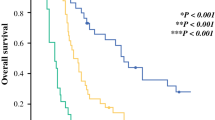Abstract
Purposes
Clinical predictive markers for the malignant potential of pancreatic neuroendocrine tumors (PNETs) are limited without histological investigation. We reported previously that a loss of the regular enhancement pattern in preoperative computed tomography (CT) was correlated with the malignant tumor phenotype. This study aimed to establish whether the metabolic aspect of the tumor evaluated by fludeoxyglucose (18F) positron emission tomography/computed tomography 18F-FDG PET/CT is associated with the tumor imaging characteristics and postoperative oncological outcome.
Methods
Among 77 patients who underwent surgery with curative intent for a PNET at our institution between 2001 and 2017, 24 who received 18F-FDG PET/CT before surgery were enrolled in this study. The clinical importance of the standardized uptake value (SUVmax) was investigated with regard to tumor progression and prognosis after curative surgery.
Results
There were four (16%) patients with insulinoma. The mean tumor size was 17 mm and when the median value of the SUVmax (= 2.0) was measured as the cut-off value, the SUVmax ≥ 2.0 group (n = 12) was associated with large tumor size (p = 0.021), high tumor grade (p = 0.015), and irregular pattern on CT (p = 0.0055). The SUVmax was not correlated with age, gender, whether the tumor was functioning or non-functioning, or lymph node metastasis. The SUVmax ≥ 2.0 group had significantly poorer disease-free survival (median, 3.5 vs 16.2 months; p = 0.023) and poorer overall survival (median, 8.8 vs 16.2 months; p = 0.042).
Conclusion
An SUVmax ≥ 2.0 on 18F-FDG PET/CT might be associated with higher malignant potential of PNETs.



Similar content being viewed by others
References
Hill JS, McPhee JT, McDade TP, Zhou Z, Sullivan ME, Whalen GF, et al. Pancreatic neuroendocrine tumors: the impact of surgical resection on survival. Cancer. 2009;115:741–51.
Yao JC, Hassan M, Phan A, Dagohoy C, Leary C, Mares JE, et al. One hundred years after “carcinoid”: epidemiology of and prognostic factors for neuroendocrine tumors in 35,825 cases in the United States. J Clin Oncol. 2008;26(18):3063–72.
Fitzgerald TL, Hickner ZJ, Schmitz M, Kort EJ. Changing incidence of pancreatic neoplasms: a 16-year review of statewide tumor registry. Pancreas. 2008;37:134–8.
Keutgen XM, Nilubol N, Kebebew E. Malignant-functioning neuroendocrine tumors of the pancreas: A survival analysis. Surgery. 2016;159:1382–9.
Madeira I, Terris B, Voss M, Denys A, Sauvanet A, Flejou JF, et al. Prognostic factors in patients with endocrine tumours of the duodenopancreatic area. Gut. 1998;43:422–7.
Ekeblad S, Skogseid B, Dunder K, Oberg K, Eriksson B. Prognostic factors and survival in 324 patients with pancreatic endocrine tumor treated at a single institution. Clin Cancer Res. 2008;14:7798–803.
Delbeke D, Martin WH. Positron emission tomography imaging in oncology. Radiol Clin North Am. 2001;39:883–917.
Hustinx R, Benard F, Alavi A. Whole-body FDG-PET imaging in the management of patients with cancer. Semin Nucl Med. 2002;32:35–46.
Kwon W, Howard BA, Herndon JE, Patz EF. FDG uptake on positron emission tomography correlates with survival and time to recurrence in patients with stage i non-small-cell lung cancer. J Thorac Oncol. 2015;10:897–902.
Engelmann BE, Loft A, Kjaer A, Nielsen HJ, Gerds TA, Benzon EV, et al. Positron emission tomography/computed tomography and biomarkers for early treatment response evaluation in metastatic colon cancer. Oncologist. 2014;19:164–72.
Shim JR, Lee SD, Han SS, Lee SJ, Lee DE, Kim SK, et al. Prognostic significance of (18)F-FDG PET/CT in patients with colorectal cancer liver metastases after hepatectomy. Europ J Surg Oncol. 2018;44:670–6.
Chung HW, Lee EJ, Cho YH, Yoon SY, So Y, Kim SY, et al. High FDG uptake in PET/CT predicts worse prognosis in patients with metastatic gastric adenocarcinoma. J Cancer Res Clin Oncol. 2010;136:1929–35.
Song BI, Kim HW, Won KS, Ryu SW, Sohn SS, Kang YN. Preoperative standardized uptake value of metastatic lymph nodes measured by 18F-FDG PET/CT improves the prediction of prognosis in gastric cancer. Medicine. 2015;94:e1037.
Okabe H, Hashimoto D, Chikamoto A, Yoshida M, Taki K, Arima K, et al. Shape and enhancement characteristics of pancreatic neuroendocrine tumor on preoperative contrast-enhanced computed tomography may be prognostic indicators. Ann Surg Oncol. 2017;24:1399–405.
Kim HS, Choi JY, Choi DW, Lim HY, Lee JH, Hong SP, et al. Prognostic value of volume-based metabolic parameters measured by (18)F-FDG PET/CT of pancreatic neuroendocrine tumors. Nucl Med Mol Imaging. 2014;48:180–6.
Masui T, Doi R, Ito T, Kami K, Ogawa K, Harada D, et al. Diagnostic value of (18)F-fluorodeoxyglucose positron emission tomography for pancreatic neuroendocrine tumors with reference to the World Health Organization classification. Oncol Letters. 2010;1:155–9.
Farrell JM, Pang JC, Kim GE, Tabatabai ZL. Pancreatic neuroendocrine tumors: accurate grading with Ki-67 index on fine-needle aspiration specimens using the WHO 2010/ENETS criteria. Cancer Cytopathol. 2014;122:770–8.
Sawayama H, Ishimoto T, Sugihara H, Miyanari N, Miyamoto Y, Baba Y, et al. Clinical impact of the Warburg effect in gastrointestinal cancer (review). Int J Oncol. 2014;45:1345–54.
Scarpa A, Chang DK, Nones K, Corbo V, Patch AM, Bailey P, et al. Whole-genome landscape of pancreatic neuroendocrine tumours. Nature. 2017;543:65–71.
Sadanandam A, Wullschleger S, Lyssiotis CA, Grotzinger C, Barbi S, Bersani S, et al. A cross-species analysis in pancreatic neuroendocrine tumors reveals molecular subtypes with distinctive clinical, metastatic, developmental, and metabolic characteristics. Cancer Disc. 2015;5:1296–313.
Funding
None.
Author information
Authors and Affiliations
Corresponding author
Ethics declarations
Conflict of interest
Takashi Matsumoto and his co-authors have no conflicts of interest.
Rights and permissions
About this article
Cite this article
Matsumoto, T., Okabe, H., Yamashita, Yi. et al. Clinical role of fludeoxyglucose (18F) positron emission tomography/computed tomography (18F-FDG PET/CT) in patients with pancreatic neuroendocrine tumors. Surg Today 49, 21–26 (2019). https://doi.org/10.1007/s00595-018-1703-2
Received:
Accepted:
Published:
Issue Date:
DOI: https://doi.org/10.1007/s00595-018-1703-2




